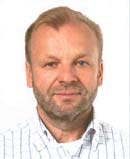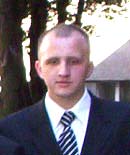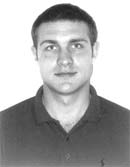Contents: 2024 | 2023 | 2022 | 2021 | 2020 | 2019 | 2018 | 2017 | 2016 | 2015 | 2014 | 2013 | 2012 | 2011 | 2010 | 2009 | 2008 | 2007 | 2006 | 2005 | 2004 | 2003 | 2002 | 2001
2007, 16
Optimization of the activity of cavitation generated by pulsed ultrasound
language: Russian
received 09.08.2007, published 28.08.2007
Download article (PDF, 440 kb, ZIP), use browser command "Save Target As..."
To read this document you need Adobe Acrobat © Reader software, which is simple to use and available at no cost. Use version 4.0 or higher. You can download software from Adobe site (http://www.adobe.com/).
ABSTRACT
The influence of duration and period of ultrasound pulses on sonoluminescence intensity is studied. Simultaneously with the photomultiplier output the hydrodphone output placed behind the focal spot of a radiator is registered in experiments. It is shown, that the dependencies of cavitation activity on pulse duration and pulse period are of extreme character. With increase of ultrasound intensity the maximum of the sonoluminescence intensity is shifted aside greater pulse periods and smaller pulse durations. The maximal cavitation activity achieved by the variation of the intensity of ultrasound is higher for lower durations and for greater periods of ultrasound pulses. From the results received it is possible to allocate two thresholds of cavitation: the first one corresponds to occurrence of light pulses, and the second one - to step-like increase of the sonoluminescence intensity. The second threshold of cavitation is characterized by the sharp increase of the absorption of ultrasound in a cavitation zone. The reason of this increase is evidently caused by the increase in volumetric bubbles concentration in a cavitation zone.
Keywords: ultrasound, ultrasound pulses, intensity, sonoluminescence, acoustical cavitation
11 pages, 7 figures
Сitation: N. V. Dezhkunov, P. V. Ignatenko, A. V. Kotukhov. Optimization of the activity of cavitation generated by pulsed ultrasound. Electronic Journal “Technical Acoustics”, http://www.ejta.org, 2007, 16.
REFERENCES
1. Журавлев А. И., Акопян В. Б. Ультразвуковое свечение. М., 1977.
2. Walton A. J. and Reynolds G. T. Advances in Physics, 1984, vol. 33, pр. 595–659.
3. Crum L. A. Physics Today, Sept. 1994, vol. 95, pp. 22–31.
4. Leighton T. G. Acoustic Bubble. Academic press, London, 1995.
5. Маргулис М. А. Звукохимические реакции и сонолюминесценция. М., 1986.
6. Маргулис М. А. Успехи физических наук, 2000, т. 170, № 3, c. 263–287.
7. Дежкунов Н. В., Ернетти Г., Прохоренко П. Г., Франческутто А., Чути П. Звуколюминесценция и генерирование субгармоники в кавитационной области водных растворов хлористого натрия. Инж.-физ. журнал, т. 51, № 3, 1986,
с. 417–424.
8. Pickworth M. J. W., Dendy P. P., Leighton T. G., Walton A. J. Studies of the cavitation effects of clinical ultrasound by sonoluminescence: 2. Thresholds of sonoluminescence from a therapeutic ultrasound beam and the effect of temperature. Phys. Med. Biol, 33, pp. 1249–1251, 1988.
9. Shuangwei Wang, Ruo Feng, Xiping Mo. Study on pulse cavitation peak in an ultrasound reverberating field. Ultrasonics Sonochemistry, 1996, 3, pp. 65–68.
10. Dezhkunov N. V., Francescutto A., Ciuti P., Mason T. J., Iernetti G., Kulak A. I., Enhancement of sonoluminescence emission from a multibubble cavitation zone. Ultrasonics Sonochemistry, 2000, 7, pp. 19–24.
11. Dezhkunov N. V., Francescutto A., Ciuti P. Enhancement of the conversion and concentration of energy in a multibubble cavitation zone. In: Nonlinear acoustics at the beginning of 21-t century. Edited by O. Rudenko and O. Sapozhnikov, MSU, Moscow, vol. 2, 2002, pp. 919–926.
12. Ciaravino V., Flynn H. G. and Miller M. W. Pulsed enhancement of acoustic cavitation: a postulated model. Ultrasound Med. Biol., vol. 7, 1981, pp. 159–166.
13. Miller M. W., Miller D. L., Brayman A. A. A review of in vitro bioeffects of inertial ultrasonic cavitation from a mechanistic perspective. Ultrasound in Med. & Biol., № 9, 1996, pp. 1131–1154.
14. Mitome H., Hatanaka S. Otpimization of a sonochemical reactor using a pulsing operation. Ultrasonics, vol. 40, 2002, pp. 683–687.
15. Flynn H. G. and Church C. C. A mechanism for the generation of cavitation maxima by pulsed ultrasound. J. Acoust. Soc. Am., 76, 1984, pp. 505–511.
16. Casadonte D., Flores M., Petrier C. Enhancing sonochemical activity in aqueous media using power modulated ultrasound: an initial study. Ultrasonics Sonochemistry, 2005, 12, pp. 147–152.
17. Дежкунов Н. В. Исследование усиления звуколюминесценции при взаимодействии сильно различающихся по частоте ультразвуковых полей. Инженерно-физический журнал, 2003, т. 76, № 1, с. 120–127.
18. Сиротюк М. Г. Мощные ультразвуковые поля. Под. ред. Л. Д. Розенберга. М., Наука, 1968, c. 167–220.
 |
Nikolay Dezhkunov, Ph. D., was born in 1952. Presently he is a head of the Laboratory for ultrasonic technologies and equipment. Research interests of N. Dezhkunov are related mainly to high-power ultrasonics including sonoluminescence, ultrasonic capillary effect and other cavitational effects. N. Dezhkunov is an author of 115 scientific publications, including two books, 57 papers in peer-reviewed journals, 41 patents. He has been granted by Belarusian Foundation for Fundamental Investigations, Belarusian National Academy of Sciences, Ministry of High Education of Belarus, International Science Foundation, INTAS and INCO-COPERNICUS European programs. On the basis of the results achieved new methods of non-destructive testing and apparatuses for high power ultrasound dosimetry - cavitometers were developed. |
|
 |
Pavel Ignatenko graduated from the Belarusian State University of Informatics and Radioelectronics (BSUIR) on the design and manufacture of electronics in 2005, is the author of two published works. Research interests: secondary cavitation effects (bubbles noise and sonoluminescence) |
|
 |
Alexei Kotukhov graduated from the Belarusian State University of Informatics and Radioelectronics (BSUIR), Department of Radioelectronics (2003). Presently he is a head of the Chemistry Department laboratory at BSUIR, participates in research projects financed by Belarusian Foundation for Fundamental Investigations, Belarusian National Academy of Sciences; INTAS European program. Scientific field: sonoluminescence, ultrasonic capillary effect and other cavitational effects, semiconductor compounds. e-mail: kavax(at)bsuir.unibel.by |
|
